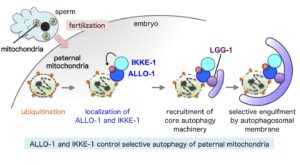Miyuki Sato (1), Katsuya Sato (1), Kotone Tomura (2), Hidetaka Kosako (3), and Ken Sato (2) (1) Laboratory of Molecular Membrane Biology, Institute for Molecular and Cellular Regulation, Gunma University (2) Laboratory of Molecular Traffic, Institute for Molecular and Cellular Regulation, Gunma University (3) Division of Cell Signaling, Fujii Memorial Institute of Medical Sciences, Tokushima University
About
In C. elegans embryos, paternally provided mitochondria are eliminated by a process of selective autophagy called allophagy, the mechanism by which mitochondrial DNA is inherited maternally. However, it remains unclear how paternal mitochondria are recognized and targeted for autophagy. Here, we identified an autophagy receptor for allophagy, ALLO-1. We also identified IKKE-1, a worm homologue of the TBK1 and IKKε family kinase, as another critical regulator of allophagy. These proteins physically interact with each other and regulate the formation of autophagosomal membrane around the paternal mitochondria. We also showed that ubiquitination of the paternal mitochondria is critical for the ALLO-1 localization. Thus, our study reveals the molecular mechanism of allophagy.
Paper information
The autophagy receptor ALLO-1 and the IKKE-1 kinase control clearance of paternal mitochondria in Caenorhabditis elegans.
Sato M, Sato K, Tomura K, Kosako H, Sato K.
Nat Cell Biol. 2017 Dec 18. doi: 10.1038/s41556-017-0008-9. [Epub ahead of print]
Online URL
https://www.ncbi.nlm.nih.gov/pubmed/?term=29255173







